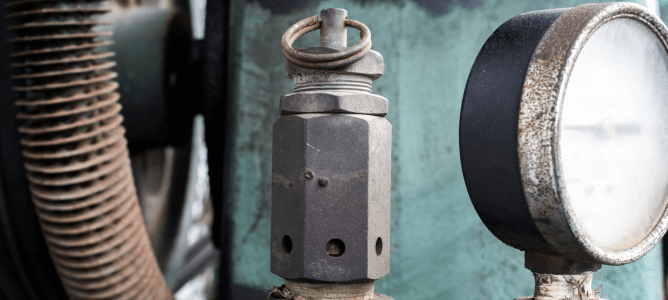
Air Compressor Safety Relief Valves: Everything You Need to Know
An air pressure safety relief valve is an important component in industrial air compressors designed to protect against overpressurization. It’s a safety measure that automatically opens when the air pressure within the system exceeds a preset limit, allowing excess air to escape and preventing potential damage to the equipment or the system itself. This controlled release ensures that the pressure remains within safe parameters.
What is an Air Compressor Relief Valve & How Does it Work?
An air pressure relief valve functions by releasing excess pressure from a compressed air system to prevent potential overpressurization and equipment damage. When the pressure in the system surpasses the valve’s predetermined setpoint, the relief valve opens, allowing the excess air to escape.
This controlled release mitigates the risk of system failure, ensuring the pressure remains within safe limits. Once the pressure returns to the acceptable range, the relief valve closes, resuming normal operation. This mechanism protected the integrity of the compressed air system and its components, promoting safety and optimal performance.
Air Compressor Safety Relief Valve – Maintenance Tips
Maintaining air compressor safety relief valves is important for ensuring the safe and efficient operation of the system. Here are some maintenance tips for air compressor safety relief valves:
- Regular Inspection: Conduct routine visual inspections of the safety relief valves to check for any signs of damage, corrosion, or wear. Ensure that the valves are free from debris and any obstructions that may hinder their proper functioning.
- Testing the Valve: Regularly test the safety relief valves to verify that they open and close as designed. Follow the manufacturer’s recommendations for testing frequency and procedures. This helps identify any potential issues before they become critical.
- Pressure Setting Verification: Periodically verify that the pressure settings on the relief valves match the specifications provided by the manufacturer. Incorrect pressure settings can compromise the safety of the entire system.
- Cleanliness: Keep the surrounding area of the relief valves clean to prevent dust, dirt, or debris from entering and affecting their operation. Regularly clean the valves and the space around them to ensure optimal performance.
- Documenting Maintenance: Maintain a record of all maintenance activities performed on the safety relief valves. Documenting air compressor audits, tests, adjustments, and any replacements will help establish a comprehensive maintenance history and aid in tracking the valves’ performance over time.
- Replace if Necessary: If any signs of wear, damage, or malfunction are detected during inspections or tests, replace the safety relief valves promptly. Delaying replacement can compromise the overall safety and longevity of the air compressor system.
- Follow Manufacturer Guidelines: Adhere to the manufacturer’s guidelines and recommendations for maintenance, inspection, and testing. Different types of safety relief valves may have specific requirements, so it’s essential to follow the guidelines provided by the valve manufacturer.
- Training Personnel: Ensure that personnel responsible for air compressor maintenance are adequately trained on safety relief valve procedures. Training should cover proper inspection techniques, testing methods, and adherence to safety protocols.
- Consult with Experts: If there are any uncertainties or if specific issues arise, consult with experts or the manufacturer for guidance. Seeking professional advice ensures that maintenance is carried out correctly, and any potential problems are addressed promptly.
- Emergency Shutdown Procedures: Familiarize personnel with emergency shutdown procedures in case the safety relief valves need to be activated. Proper training in responding to emergency situations enhances overall safety measures.
By consistently following these maintenance tips, you can ensure that air compressor safety relief valves operate effectively, contributing to a safe and reliable compressed air system. Regular inspections, air compressor testing, and adherence to manufacturer guidelines are key components of a comprehensive maintenance strategy.
Discover NiGen’s Industrial Air Compressor Solutions
NiGen’s cutting-edge technologies and expert engineering ensure the optimal performance, reliability, and safety of your compressed air systems. From air pressure relief valves to advanced maintenance solutions, NiGen is committed to elevating the efficiency of your operations. Explore our range of industrial air compressor rentals and discover how NiGen can be your trusted partner in achieving peak performance and longevity for your compressed air systems.
Contact us today to embark on a journey toward enhanced reliability and efficiency in industrial air compression.
